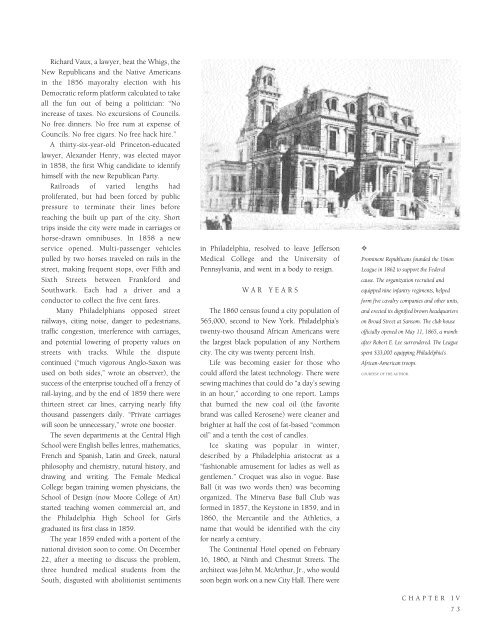Historic Philadelphia
An illustrated history of the city of Philadelphia, paired with the histories of companies, families and organizations that make the region great.
An illustrated history of the city of Philadelphia, paired with the histories of companies, families and organizations that make the region great.
Create successful ePaper yourself
Turn your PDF publications into a flip-book with our unique Google optimized e-Paper software.
Richard Vaux, a lawyer, beat the Whigs, the<br />
New Republicans and the Native Americans<br />
in the 1856 mayoralty election with his<br />
Democratic reform platform calculated to take<br />
all the fun out of being a politician: “No<br />
increase of taxes. No excursions of Councils.<br />
No free dinners. No free rum at expense of<br />
Councils. No free cigars. No free hack hire.”<br />
A thirty-six-year-old Princeton-educated<br />
lawyer, Alexander Henry, was elected mayor<br />
in 1858, the first Whig candidate to identify<br />
himself with the new Republican Party.<br />
Railroads of varied lengths had<br />
proliferated, but had been forced by public<br />
pressure to terminate their lines before<br />
reaching the built up part of the city. Short<br />
trips inside the city were made in carriages or<br />
horse-drawn omnibuses. In 1858 a new<br />
service opened. Multi-passenger vehicles<br />
pulled by two horses traveled on rails in the<br />
street, making frequent stops, over Fifth and<br />
Sixth Streets between Frankford and<br />
Southwark. Each had a driver and a<br />
conductor to collect the five cent fares.<br />
Many <strong>Philadelphia</strong>ns opposed street<br />
railways, citing noise, danger to pedestrians,<br />
traffic congestion, interference with carriages,<br />
and potential lowering of property values on<br />
streets with tracks. While the dispute<br />
continued (“much vigorous Anglo-Saxon was<br />
used on both sides,” wrote an observer), the<br />
success of the enterprise touched off a frenzy of<br />
rail-laying, and by the end of 1859 there were<br />
thirteen street car lines, carrying nearly fifty<br />
thousand passengers daily. “Private carriages<br />
will soon be unnecessary,” wrote one booster.<br />
The seven departments at the Central High<br />
School were English belles lettres, mathematics,<br />
French and Spanish, Latin and Greek, natural<br />
philosophy and chemistry, natural history, and<br />
drawing and writing. The Female Medical<br />
College began training women physicians, the<br />
School of Design (now Moore College of Art)<br />
started teaching women commercial art, and<br />
the <strong>Philadelphia</strong> High School for Girls<br />
graduated its first class in 1859.<br />
The year 1859 ended with a portent of the<br />
national division soon to come. On December<br />
22, after a meeting to discuss the problem,<br />
three hundred medical students from the<br />
South, disgusted with abolitionist sentiments<br />
in <strong>Philadelphia</strong>, resolved to leave Jefferson<br />
Medical College and the University of<br />
Pennsylvania, and went in a body to resign.<br />
WAR<br />
YEARS<br />
The 1860 census found a city population of<br />
565,000, second to New York. <strong>Philadelphia</strong>’s<br />
twenty-two thousand African Americans were<br />
the largest black population of any Northern<br />
city. The city was twenty percent Irish.<br />
Life was becoming easier for those who<br />
could afford the latest technology. There were<br />
sewing machines that could do “a day’s sewing<br />
in an hour,” according to one report. Lamps<br />
that burned the new coal oil (the favorite<br />
brand was called Kerosene) were cleaner and<br />
brighter at half the cost of fat-based “common<br />
oil” and a tenth the cost of candles.<br />
Ice skating was popular in winter,<br />
described by a <strong>Philadelphia</strong> aristocrat as a<br />
“fashionable amusement for ladies as well as<br />
gentlemen.” Croquet was also in vogue. Base<br />
Ball (it was two words then) was becoming<br />
organized. The Minerva Base Ball Club was<br />
formed in 1857, the Keystone in 1859, and in<br />
1860, the Mercantile and the Athletics, a<br />
name that would be identified with the city<br />
for nearly a century.<br />
The Continental Hotel opened on February<br />
16, 1860, at Ninth and Chestnut Streets. The<br />
architect was John M. McArthur, Jr., who would<br />
soon begin work on a new City Hall. There were<br />
✧<br />
Prominent Republicans founded the Union<br />
League in 1862 to support the Federal<br />
cause. The organization recruited and<br />
equipped nine infantry regiments, helped<br />
form five cavalry companies and other units,<br />
and erected its dignified brown headquarters<br />
on Broad Street at Sansom. The club house<br />
officially opened on May 11, 1865, a month<br />
after Robert E. Lee surrendered. The League<br />
spent $33,000 equipping <strong>Philadelphia</strong>’s<br />
African-American troops.<br />
COURTESY OF THE AUTHOR.<br />
CHAPTER IV<br />
73
















